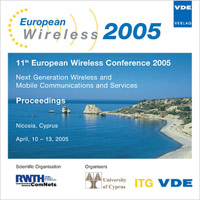Design and Evaluation of a New Handoff Protocol in IEEE 802.11 Networks
Conference: European Wireless 2005 - 11th European Wireless Conference 2005 - Next Generation wireless and Mobile Communications and Services
04/10/2006 - 04/13/2005 at Nicosia, Cyprus
Proceedings: European Wireless 2005
Pages: 6Language: englishTyp: PDF
Personal VDE Members are entitled to a 10% discount on this title
Authors:
Weiss, Erik; Otyakmaz, Arif; López, Eva (Communication Networks, Aachen University of Technology, Kopernikusstr.16, 52074 Aachen, Germany)
Xu, Bangnan (SSC ENPS (Technologiezentrum), T-Systems, Am Kavalleriesand 3, 64295 Darmstadt, Germany)
Abstract:
Nowadays IEEE 802.11 is the most used WLAN standard. Many hotspots composed of many different Access Points (AP) are deployed today. 802.11b varies between 2-11Mbs. The next step is 802.11a/g, supporting data rates up to 54Mbps. 802.11a/g is based on more complex coding schemes to ensure high data rates. The physical layer improves but the protocol basics are the same since legacy 802.11. This paper presents a detailed analysis of the handover mechanisms described in the IEEE 802.11 standard. Based on the analysis we present an enhanced handover mechanism, utilising the wired infrastructure and the gained knowledge about the neighbourhood. We present an approach called “Cooperated Handover Control” (CoHCo). This paper compares CoHCo with the basic handover methods of IEEE 802.11 by computer simulations.


